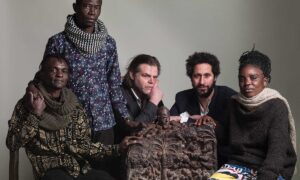[ad_1]

After three weeks, the closely watched civil fraud trial between Sotheby’s and the Russian billionaire Dmitry Rybolovlev reached its finale in a Manhattan district courtroom on 30 January. Although the verdict appears to have (finally) ended the lengthiest legal dispute in art market memory, industry experts seem to agree it will do little to shake up how the trade operates going forward.The jury needed only a few hours of deliberation to dismiss all charges against Sotheby’s related to the private sales of the four works at the trial’s centre: Salvator Mundi (around 1500), infamously reattributed to Leonardo da Vinci; Gustav Klimt’s 1907 canvas Wasserschlangen II (water serpents II); René Magritte’s 1938 painting Le Domaine d’Arnheim (the domain of Arnheim) and the Amedeo Modigliani sculpture Tête (head, 1911-12).These four works were among 38 that Rybolovlev’s family trusts, Accent Delight International and Xitrans Finance, paid roughly $2bn to acquire through the Swiss dealer Yves Bouvier between 2003 and 2014. Rybolovlev has accused Bouvier of overcharging him by as much as $1bn for the collection despite being hired, Rybolovlev says, to act as an agent on his behalf rather than as a dealer free to set his own prices. Bouvier has maintained for more than a decade that both sides understood his role to be the latter.After a series of lawsuits and investigations, Bouvier and Rybolovlev agreed to settle their disputes in all jurisdictions in November 2023. (Bouvier has never been convicted of any crime anywhere.) This left Rybolovlev’s civil complaint against Sotheby’s as a kind of proxy battle to recover some of what he believes he is owed. At issue in the trial was whether Sotheby’s had “substantially assisted” in fraud through its interactions with Bouvier (who was not a party to the lawsuit) surrounding his resale of the works.The jury’s answer was a resounding no—an outcome that seems to have surprised few, if any, veterans of the art market.“Most people knew a lot of these facts already,” says Morgan Long, a London-based adviser and the former managing director of The Fine Art Group, about the proceedings. After all, the saga between Rybolovlev and Bouvier had been unfolding in the press and courtrooms around the world since 2015, with no real success for Rybolovlev, meaning new revelations were likely needed to shift opinions.In the end, Long adds, those revelations never arrived: “The facts were the facts, and there was no other way of presenting them, let alone to a jury not really used to the ins and outs of the art world.”Another well-placed source gave The Art Newspaper an even blunter assessment: “I don’t think anyone in the art world bats an eye at how the business was done here, and I don’t think anyone believes the business is going to be different on the other side of this.”Contracts, obligations and their absencePivotal to the case was the laissez-faire approach that Rybolovlev and Mikhail Sazonov, who oversaw the billionaire’s trusts for more than 15 years, took toward building a multibillion-dollar art collection.Both Rybolovlev and Sazonov admitted in their testimony that a contract was never drawn up to precisely define the arrangement with Bouvier. In fact, Rybolovlev said that he never even followed up with Sazonov to confirm the latter had acted on his wishes for a formalised agreement until the end of 2014, at which point he suspected Bouvier may have defrauded him to a cosmic extent.Ahead of the trial, the absence of a contract was always viewed as the central oddity and central weakness in Rybolovlev’s case. It is also the primary reason so many art market insiders believe there is so little to learn in the aftermath.The verdict certainly reinforces the fact that it is hugely risky to spend thousands (let alone billions) of dollars on art without applying the same rigorous due diligence and ironclad contracts that have long been standard in similar scale transactions for real estate, corporate mergers and acquisitions and more. So it is possible that art advisers and collectors may now ask slightly more, slightly firmer questions about the finer points of any proposed art deal, such as the identity of the actual seller and the exact role of any other intermediaries involved, as well as the source, purpose and other recipients of any art valuations provided during negotiations.But insiders agree that wise intermediaries and collectors were already doing the above before the jury dismissed Rybolovlev’s claims against Sotheby’s, minimising the trial’s practical impact. And those inclined to be reckless are unlikely to be chastened by a verdict largely viewed as a foregone conclusion a long time in arriving.The two schools of thought about the business were most visible in the difference between Rybolovlev’s dealings with Bouvier and his dealings with Sandy Heller, the powerful New York-based adviser the Russian hired after cutting ties with Bouvier. Signing a contract was the first step in establishing the arrangement with Heller, whose operation is synonymous with buttoned-up professionalism.Long, the London-based adviser, in this way considers Heller “a harbinger of the business to come”, adding of Rybolovlev’s legal tussle with Sotheby’s: “Maybe that’s really what it comes down to: a trial of old-school operation versus new-school operation.”The cost of doing businessOne of the only silver linings for Rybolovlev is that the court awarded Sotheby’s no compensatory damages, the term for money owed by one litigant to repair the harm judged to have been done to the other. Most notably, this means the auction house remains responsible for its own legal bills pertaining to the case.Those bills are undoubtedly substantial. Sources with experience in high-level US litigation estimate that the auction house probably spent between $8m and $10m on the three-week trial and the preparations in its immediate lead-up—and perhaps around $40m for all legal services dating back to the filing of the original complaint on behalf of Rybolovlev’s trusts in October 2018. The expense may seem huge until one considers the potential downside of scrimping: Rybolovlev’s side was petitioning the court for at least $190m in damages.In the ruling’s immediate aftermath, the billionaire’s lawyers tried to emphasise that they had nonetheless won a kind of ethical victory. “This case achieved our goal of shining a light on the lack of transparency that plagues the art market. That secrecy made it difficult to prove a complex aiding and abetting fraud case,” Daniel Kornstein, one of the lawyers representing Rybolovlev’s trusts, said in a statement. “This verdict only highlights the need for reforms, which must be made outside the courtroom.”Multiple sources agree that Sotheby’s has at least modestly refined its procedures in the more than ten years that have elapsed since the transactions at issue in the trial. Only two days after the verdict, the auction house also announced a radically new fee structure that “simplifies and clarifies auction transaction costs for all involved”, according to a press statement.Despite the conspicuous timing and language of the overhaul, however, its scale indicates it was a long-term initiative with complex motivations, not a capricious response to Rybolovlev’s fraud accusations. More important may be that multiple art professionals contacted by The Art Newspaper found the new fees neither simple nor clarifying, suggesting that the more things change in the art business, the more they stay the same.In this vein, the consensus within the trade is arguably embodied in a statement released by David Bitton and Yves Klein, Bouvier’s lawyers in Geneva, after the jury’s decision came down: “The time has come to turn the page on this case that should have never happened in the first place.”Salvator, deliver us from boredomAlthough the three-week trial between Dmitry Rybolovlev and Sotheby’s largely consisted ofadministrative minutiae and evidence known within the industry for years, at least a few true revelations emerged at the margins. Here are three to remember concerning the Salvator Mundi, the painting that simply cannot stay out of the news cycle, even nearly seven years after Rybolovlev resold it for $450.3m at Christie’s in New York.Silent witness: testimony revealed a few fascinating details about the sale of Salvator Mundi The Picture Art Collection/Alamy Stock PhotoSotheby’s gave it a Hollywood codenameIt is not uncommon for the top auction houses to disguise the identity of trophy works or key clients in internal communications, lest a hack, a betrayal or carelessness give competitors valuable insight into major deals in progress. Here, Sotheby’s executives codenamed Salvator Mundi “Jack” in homage to Leonardo DiCaprio’s character in the film Titanic. One money-making Leonardo deserved another, apparently…A second Russian billionaire was chasing itAlexander Bell, Sotheby’s co-head of Old Master paintings, testified that, months before the Old Master dealers Robert Simon, Alexander Parish and Warren Adelson sold Salvator Mundi to Yves Bouvier, Adelson rejected an offer from Andrey Melnichenko, the industrialist sometimes described as Russia’s richest man, to buy the painting for between $120m and $125m. Instead, the trio later settled for $80m from Bouvier, who flipped the painting to Rybolovlev for $127.5m.The commission it brought Sotheby’s was historically weakFormer Sotheby’s executive Bruno Vinciguerra testified that the house’s fee for brokering the sale to Bouvier was the lowest he could recall accepting during his roughly seven years as its chief operating officer. He said Sotheby’s typically angles for 10% of the sale price in private transactions, receives 8% to 9% on average—and requires approval from senior leadership for any proposed commission at or below 6%. The $3m Sotheby’s made for facilitating the Salvator Mundi sale was just 3.75% of its $80m price.
[ad_2]


























